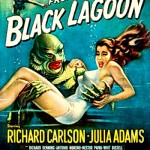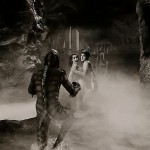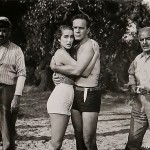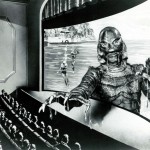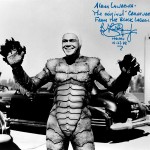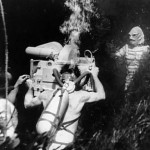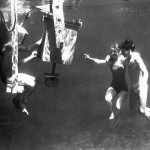As the Creature approaches sixty-five and plans to sign up for medicare, there are no signs of him slowing down, he is more popular than ever. Collectors love the film, a one sheet poster recently sold for $24 thousand and even the re-issue posters are demanding top-dollar. Any of the eight lobby cards are selling for several hundred dollars a piece. As 1953 was the big release year for 1950′s 3D films, we will be celebrating a 65th anniversary for all of our favorite films.
“Creature from the Black Lagoon” (CFTBL) as so many ‘creature’ films before and since, is a classic ‘Beauty and the Beast’ story. CFTBL first surfaced when it was previewed in Los Angeles on January 7, 1954, the film premiered in Detroit, Michigan and Denver, Colorado on February 12, 1954. It was distributed regionally, with its official U.S. release date March 5, 1954. This film, as well as most of the other final dozen 3D films of the 1954 3D heyday, received a limited 3D release, yet it did spawn a 3D sequel the following year and a 2D sequel two years later. In only fifteen months from the November 26, 1952 Hollywood opening of “Bwana Devil” when lines wrapped around two theaters and Hollywood jumped on the 3D bandwagon, the studios had all moved on from 3D to wide screen. CFTBL 3D posters were never produced, instead they provided a 3D snipe for the 2D posters. The only promotional item produced with 3D listed was the 14′ x 22′ window card. The press book also promoted a View-Master reel for theater lobbies, that was not produced.
To help illustrate how much of a box-office poison 3D had become, one of the top box-office films for 1954 was “Rear Window,” an Alfred Hitchcock film released on September 1, 1954 by Paramount. It grossed $27.6 million dollars, quite a bit more than the 3D film which Warner Bros. had released from Hitchcock only three months prior. The 1954 gross for “Dial M For Murder” was only $2.7 million, ranking at number 17. “Dial M” received its wide release on May 29, 1954 and after the audience stayed away from the planned 3D shows, theaters asked to show it in 2D. Hitchcock stated of 3D, “It’s a nine-day wonder and I came in on the ninth day.”
Producer William Alland suggested the idea for CFTBL, based on a story he heard at a 1941 dinner party around the time he was playing the back-to-the-camera, face-in-the-shadows reporter Thompson in “Citizen Kane” (1941). On October 2, 1952, Alland wrote a three-page memo titled ‘The Sea Monster’ and over the next ten months it went through several re-writes. Finally screenwriter Harry J. Essex turned in a second draft on August 7, 1953 for the film, which was to be called “Black Lagoon.” Universal-International had paid $16,591 to three different writers and with miscellaneous extras, the total cost of writing was $23,734. Universal was famous for their monsters and they were about to introduce their newest movie monster, one that would help make the studio profitable again after a move to bring ‘prestige’ to the company had not been successful.
When covering the budget all aspects were discussed and planned. Basing the costs on an April 1953 screenplay, Universal looked at the different costs, if it was shot as a 2D black and white film, the cost was estimated at $600,000; in Eastman color and 2D an estimated $675,000; a black and white 3D an estimated $650,000 and in Eastman color 3D $750,000. These figures included a 35 percent studio overhead, cast, etc. With script changes the final budget was set at $550,000, the actual cost came in at $613,243. Over the years the financial success of the film has been inflated. You may have heard that in the first year the film grossed $3 million, the official 1954 gross is $1.3 million. You may have heard that the sequel “Revenge of the Creature” (1955) out-performed the original, the official 1955 gross for the sequel is $1.1 million. There is certainly no question the series was a financial success for the studio and the fans continue to grow.
The cast and crew were not new to 3D. Director Jack Arnold had directed “It Came From Outer Space” (1953), “The Glass Web” (1953) and would also direct “Revenge of the Creature.” Producer William Alland produced “It Came From Outer Space” and would produce all three Creature films. Richard Carlson had starred in “It Came From Outer Space” and “The Maze” (1953). Julie Adams had starred in “Wings of the Hawk” (1953). Actor Richard Denning had appeared in “The Glass Web,” and “Jivaro” (1954). Writer Harry Essex did the screenplay for “It Came From Outer Space,” screen adaptation for “Devil’s Canyon” (1953), he was director and screenwriter for “I, The Jury” (1953) and he would write and do the screenplay for “Southwest Passage” (1954). Plus most of the supporting cast had appeared in 3D films.
The Creature’s costume had gone through 8½ months of research and experiments. Fashioned of foam rubber, plastic, hidden controls and specially-tailored fittings, the final costume was the end result of 76 different body sketches, 32 different head models and 176 pounds of foam rubber; this for two creature actors, Ben Chapman on land and Ricou Browning underwater; valued at $18,000. Pre-production filming began on September 30, 1953, with production beginning on October 6, 1953 on the Universal lot. The underwater second unit filming began in Florida on October 13th. Florida filming was completed on October 30th. California filming wrapped on Halloween, with some retakes and inserts being shot on November 10th. On November 12, Universal executive Sam Israel issued a memo stating that the title had been officially changed to “The Creature from the Black Lagoon,” yet ‘The’ would not be used in the final title. On November 24th a crew shot the final scene pick-up at Will Rogers Beach.
Unlike today’s films, in the 1954 studio system, screen credit was not given to most of the individuals who actually worked on a film. Only Musical Supervisor Joseph Gershenson received screen credit on CFTBL. But the score was the collaborative effort of a number of musicians, including Herman Stein, Hans J. Salter and a 29 year old Henry Mancini. Music from numerous earlier Universal films can be heard, plus the CFTBL music was recycled in many future Universal films.
In 1953 Pola-Lite began promoting single strip 3D projection, a feature that would have solved the too-often reported sync issues. It would have required more light, but would have eliminated the necessary 3D intermission to change reels. I believe, if 3D had been rolled out this way, we may have seen a longer life for 3D in the 1950′s. Universal was the first to offer two films in Pola-Lite, CFTBL and “Taza, Son of Cochise” (1954), which was released on February 18, 1954. Pola-Lite also promoted “Gorilla at Large” (1954), “Southwest Passage” (1954) and “Gog” (1954) as available as single prints, but Bob Furmanek reports that the studio confirmed the last two films were never printed as single strip prints.
The Universal publicity department started prior to the film’s release. On Saturday, February 20, 1954, Julie Adams plugged CFTBL during the national telecast of the Heavyweight Championship Wrestling Match. The following night Ben Chapman in costume appeared on the live television show ‘The Colgate Comedy Hour’ with guest stars Abbott and Costello. Glenn Strange appeared as Frankenstein’s monster, introducing the Creature to a national audience. Other promotions for CFTBL included an article in a surfer magazine and an article in the May 1954 issue of ‘How-To-Do’ magazine ‘Mechanix Illustrated,’ letting the cat out of the bag that the Creature was played by Ben Chapman, but no mention of Ricou Browning as the underwater creature. To illustrate how loved CFTBL had become a year after the film’s release, Marilyn Monroe goes to see the film in competing studio 20th Century Fox’s “The Seven Year Itch,” released on June 3, 1955 and discusses how the Creature is misunderstood.
CFTBL was re-released in 1964 and was seen often over the years on television. Following the 1971 re-issue of “House of Wax” in a single strip Stereovision print, Universal planned to re-issue both “Creature” and “It Came from Outer Space.” When the prints materialized in 1975, they chose to issue them in an anaglyph version (red/blue glasses.) 16mm rental versions and 8mm short versions followed in 1976. Anaglyph versions played for many years in theaters. “Revenge” was shown on television along with other 1950′s 3D films also in anaglyph. Finally with the advent of digital 3D projection and 3D blu-rays Universal produced a 3D blu-ray, using the original 35mm negatives and a 4K per eye transfer, things were looking up. Unfortunately, they did the restoration work in-house and did not fix problems that can cause eyestrain. This would have been the time to fix vertical misalignment and at least one pseudoscopic shot. But even worse they created new problems by adjusting the stereo window.
Ricou Browning played the underwater Creature in all three of the Creature features. He asked about screen credit for “Revenge,” but the studio didn’t want to ruin the illusion, that the Creature may actually exist. They did attempt to appease him by offering him another small role in the film as a lab technician, were we also see Clint Eastwood in his first film performance. I am happy due to their autograph appearances, I have not only met Browning and Ben Chapman, but CFTBL star Julie Adams on several occasions. Chapman passed away in 2008 at age 79. Browning and Adams have continued making appearances. Adams at almost 92 is finally slowing down, but she did appear at the San Fernando Valley Comic Book Convention on March 18th. Ms. Adams was very gracious to appear and answer questions at a 60th anniversary 3D screening of CFTBL presented by 3-D SPACE during the 2014 Mosterpalooza.
The American Film Institute (AFI) had nominated CFTBL twice, in 2001 for AFI’s 100 Years…100 Thrills and in 2003 for AFI’s 100 Years…100 Heroes & Villains. But one of CFTBL biggest successes must be that the film partly inspired Guillermo del Toro’s “The Shape of Water” (2017) which won the Best Picture Oscar from the Academy of Motion Picture Arts and Sciences.
